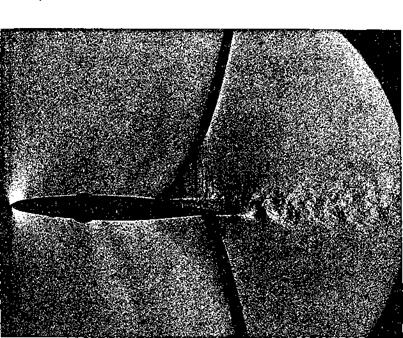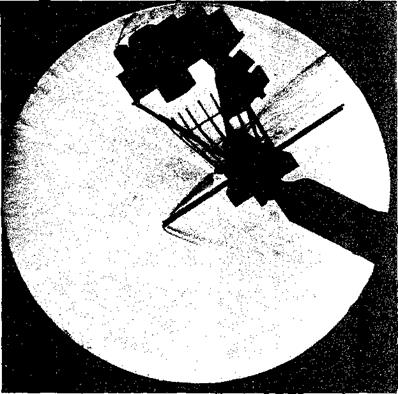BUFFETING AND STALL FLUTTER
9.1 BUFFETING PHENOMENON
Buffeting is an irregular motion of a structure or parts of a structure in a flow, excited by turbulences in the flow.
Historically, the term buffeting was originated in connection with an accident of a commercial airplane (type Junkers F13) at Meopham, England, on July 21, 1930. Four passengers and two pilots were killed. Eye witnesses to the accident could report only seeing the airplane enter a cloud, hearing a loud noise almost immediately, and seeing the fragments fall to the ground.9,2 The unusual circumstances of the accident led scientific organizations in England and Germany to undertake detailed investigations of the possible causes. The British Aeronautical Research Committee conducted extensive laboratory investigations and concluded that the most probable cause of the accident was “buffeting” of the tail. In these wind-tunnel-model investigations it was established that at large angles of attack the tail vibrated intensely but irregularly, and the “mean” amplitude of the vibration increased with the increase of speed of flow. An investigation of the meteorological circumstances at Meopham indicated the presence of strong rising air currents. Hence, an explanation of the cause of the Meopham accident was offered as follows: The airplane, flying horizontally at high speed, suddenly entered a region of strong rising gusts; as a result there was a sharp increase in the angle of attack, with the formation of flow separation over the wing. The tail, situated in the wing wake, was subjected to intense forced vibrations caused by the turbulences in the separated flow, which brought about the accident. The term buffeting was used by the British investigators and was explained as irregular oscillations of the tail unit, in which the stabilizer bent rapidly up and down and the elevator moved in an erratic manner.
About the same time, German scientists Blenk, Hertel, and Thalau0,5 conducted a series of laboratory and flight tests, using the same type of airplane as the one involved in the Meopham accident. The laboratory investigations showed that it was possible for the airplane to buffet, but in actual flight, except during a steep dive, buffeting of sufficient intensity to endanger the structures of the tail was not observed. For this reason,
Blenk concluded that the Meopham accident was probably caused by overstressing of the wing due to high gust or maneuvering load. Buffeting was investigated by means of motion pictures in flight. The following conclusions were reached:
 |
1. The tail surfaces, at large angles of attack of the wing, entered a region of vortices springing from the intersection of the wing and fuselage,
and vibrations were observed. The vortices arose on both sides of the fuselage, usually in an unsymmetrical manner. The tail vibrations were irregular in amplitude and frequency; and, as a rule, large amplitudes were rare and continued only for a very short time.
2. The recorded amplitudes, plotted against the corresponding frequencies, showed clearly three resonances. These resonance frequencies corresponded with the first three natural frequencies in the dynamic tests in the hangar.
3. The amplitudes increased slowly with the flight speed.
In 1933, Duncan and his associates published two papers on buffeting.9-7’98 In an attempt to separate numerous factors, Duncan investigated the case where the airfoil creating the disturbances was of infinite aspect ratio and where a “detector” (which played the part of a buffeting tail surface) was so arranged that its only possible movement was bending about a pair of flexural hinges, and, hence, it had only a single natural frequency. The oscillations of the detector were recorded optically. The relative position of the detector and the wing in front could be changed both vertically and horizontally. Hence, it was possible to explore a whole region behind the-wing. The most interesting feature of these tests is illustrated in Fig. 9.1, in which contours of equal “buffeting intensity” are plotted. Here the “buffeting intensity” means the greatest total range of movement of the detector during a standard exposure of the camera. In the same figure is shown the width of the wake as obtained by a total – head tube.[26] Note that the buffeting-intensity contours do not coincide with the total-head wake.
Since these early researches show that tail buffeting is a result of flow separation, it is clear that tail buffeting can be prevented by preventing separation. This can be effected by a proper filletf at the wing-fuselage junction, by boundary-layer control, and by limiting the operating conditions of the airplane. Tail buffeting can also be avoided by locating the airfoil outside the region where disturbances exist.
For modern high-speed airplanes, flow separation over the wing or the wing-fuselage junction at transonic speeds of flight causes a very serious
|
|
Schlieren photograph of the eddying wake following a shock-induced
flow separation. The dark lines are shock waves. (Courtesy of
National Physical Laboratory, England; photo by D. W. Holder)
|
|
Schlieren photograph of a 10 per c:ent scale model of the Nimbus spacecraft with Snap-19 generator in the 50-inch Hypersonic Tunnel В at Mach number 8 and Reynolds number of 0.42 X 10c per fool. Photo by Optical Systems group. Von Karman Gas Dynamics Facility, ARO, Inc. Arnold Engineering Development Center, Arnold Air Force Station, Tennessee.
problem of tail buffeting. Tail buffeting of very high intensity has been observed. The general feature as demonstrated in Fig. 9.1 remains in a transonic flow, although the contour lines are different. The intensity of turbulence and the location of the highest intensity change with the wing thickness, camber, and angle of attack. Separation of the flow at the leading edge of a thin wing at moderate angles of attack causes the most severe tail buffeting. Control over such leading-edge separation, for instance, by proper camber near the leading edge, will be most helpful in reducing the intensity of tail buffeting at transonic speeds.
The general picture is therefore as follows: Whenever separation occurs in a flow, the turbulence level increases. If an airfoil is situated in a turbulent flow, it buffets. The term buffeting, however, will not be limited to airfoils. The oscillation of a smokestack in the wake of another smokestack is also an example of buffeting.
In § 9.2 the limits of the flight speed and the angle of attack beyond which tail buffeting may occur are discussed. In § 9.3 some remarks on the theories of tail buffeting are given. Buffeting of an airfoil caused by flow separation over the airfoil itself, in a flow which is otherwise free from turbulence, will be discussed in § 9.6.













